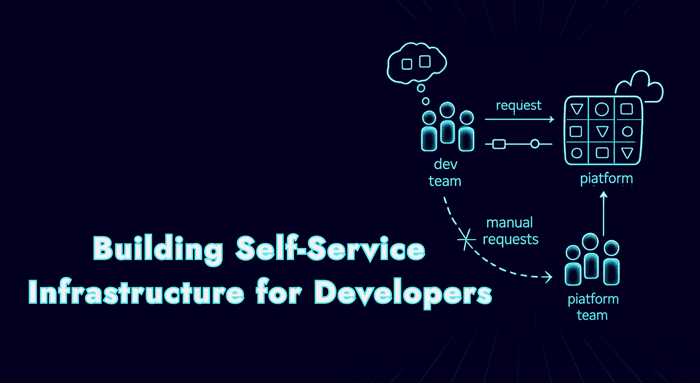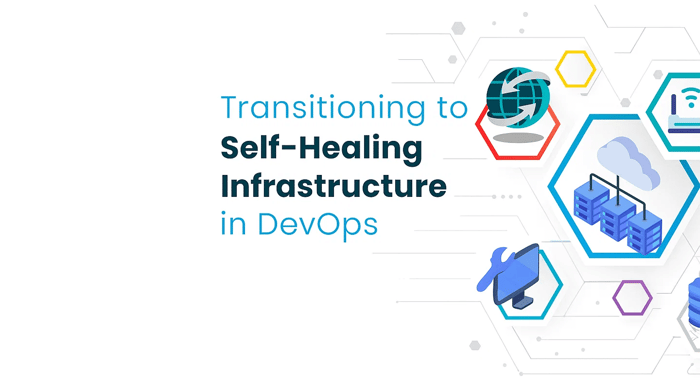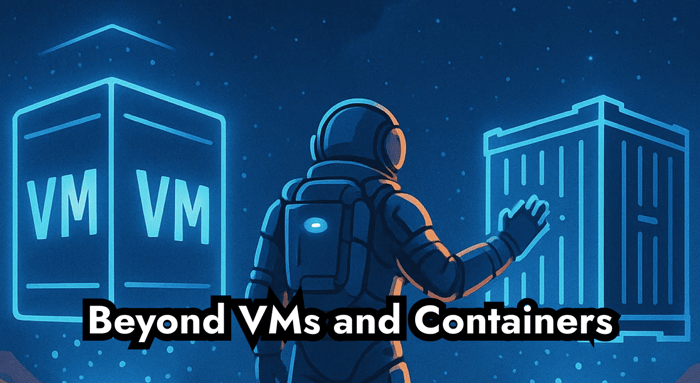Table of Contents
A comprehensive guide to designing and implementing self-service infrastructure that empowers developers and accelerates delivery.
Over the past ten years, we've seen a significant transformation in how software is delivered. Gone are the days when developers had to wait for operations teams to handle every request. Now, speed and autonomy are key factors for success. Organizations that give developers the ability to access infrastructure on their own find themselves with a powerful advantage. By reducing bottlenecks and speeding up delivery, teams can focus on what they really love: building great products instead of getting bogged down with approvals and ticket management.
Self-service infrastructure platforms are designed to give developers on-the-spot access to everything they need, like environments, pipelines, secrets, and monitoring tools. They do this through user-friendly interfaces such as command-line tools, web portals, or workflows that integrate with Git. By simplifying the complex aspects of resource management, these platforms let developers take charge of their resources while still maintaining important standards for governance, compliance, and security. This balance between freedom and control has become essential in today’s platform engineering landscape.
The industry is clearly moving in this direction. According to Gartner, it’s predicted that by 2026, 80% of large software engineering companies will have dedicated platform engineering teams focused on delivering reusable services and tools as internal products. Companies like ABN AMRO and Adidas are already demonstrating the benefits of self-service platforms. They’re showing that when infrastructure is well-designed, it can significantly improve the developer experience and enhance the organization’s agility.
This article digs into the core concepts behind self-service infrastructure. We’ll explore the guiding principles, the architectural patterns that make it work, the tools that support it, and the governance strategies that ensure it remains sustainable over time.
What is Self-Service Infrastructure?
Self-service infrastructure is all about empowering developers by giving them the tools and processes they need to manage resources on their own. This means they can build, test, and run their software without having to rely on IT or operations teams. Essentially, it streamlines the software development process by allowing developers to directly access the infrastructure and services they require, all while maintaining necessary controls.
Think of a self-service platform as a one-stop shop for approved resources. Developers can easily create environments, deploy applications, request access to credentials, or set up databases using ready-made templates. Behind the scenes, all the heavy lifting, like setting things up, managing access, and ensuring compliance, is handled by automation. This setup not only helps developers work more efficiently but also ensures that the organization keeps a handle on governance, security, and visibility over the entire process.
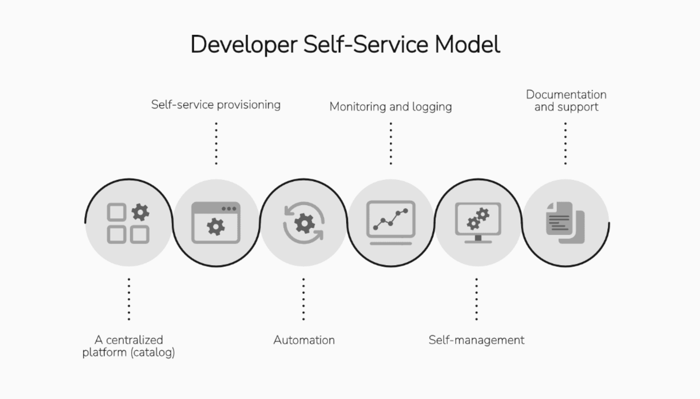
The way we approach IT operations has changed dramatically. In the past, a developer would submit a request for infrastructure and then face a frustrating wait that could stretch on for days or even weeks. But now, thanks to self-service options, that same task can be done in just a few minutes using a command-line interface, a portal, or a GitOps workflow. This transformation not only speeds up the delivery process but also frees up operations teams from having to handle repetitive tasks that aren't very fulfilling.
Examples of self-service in action include:
Provisioning a new Kubernetes namespace for testing.
Deploying a staging environment through a pipeline.
Requesting secrets or API credentials via a secure vault.
By abstracting complexity and automating repeatable tasks, self-service infrastructure enables developers to focus on innovation rather than operations, while still aligning with organizational standards.
Business and Technical Benefits
The beauty of self-service infrastructure is how much faster it makes things. Instead of waiting around for days for IT to get around to setting up resources, developers can create environments or request credentials in just a few minutes. This quick turnaround cuts down on delays in the software development process, allowing teams to deliver features more quickly and respond to market changes without missing a beat.
Another perk of self-service is scalability. As teams grow, the old ticketing system can become a real bottleneck, piling up requests on operations staff. With self-service, teams can handle their own provisioning using standardized templates and automated workflows. This makes it easier for organizations to increase engineering capacity without having to hire an army of operations personnel.
Developer experience, or DevEx, also gets a boost. When developers aren’t bogged down by endless layers of approval, they can experiment, test, and deploy more freely. This not only makes their jobs more enjoyable but also helps retain talent, as engineers can focus on solving challenges instead of wading through bureaucratic processes.
Managing costs becomes simpler, too. With self-service platforms, organizations can track and visualize resource usage, giving them clearer insights into cloud spending. Features like quotas, automated cleanup, and policy-based approvals help prevent waste from over-provisioning, keeping budgets in check.
Importantly, embracing self-service doesn’t mean sacrificing security or compliance. A well-structured platform incorporates role-based access control, monitoring, and policy enforcement right into the workflows that developers use every day. This ensures that the quest for speed and freedom goes hand-in-hand with the necessary governance and standards organizations must uphold.
In summary, self-service infrastructure enhances delivery speed, adapts to team growth, improves the developer experience, and gives organizations better control over costs and compliance. It’s truly a game-changer for modern software delivery.
Core Principles of Self-Service Infrastructure
Creating a successful self-service infrastructure platform isn’t just about piecing together some scripts and dashboards. It’s about following key principles that strike a balance between speed and autonomy while also keeping governance, security, and reliability in mind. These guiding principles influence how platform engineering teams design, build, and maintain services that developers can trust and widely adopt. It's all about making sure that what we create not only empowers developers but also meets the necessary standards for safety and efficacy.
Automation First
Think of Infrastructure as Code (IaC) as a way to build and manage environments, pipelines, and policies consistently, no matter which team you're on. By automating workflows, we can eliminate manual tasks and reduce the chances of human error, making everything run more smoothly and predictably. This approach gives developers a reliable "paved road" to follow, allowing them to work with confidence and focus on what really matters.
Security and Compliance by Default
When building platforms, it's crucial to weave security and compliance into the fabric of the workflow right from the beginning. Instead of setting up hurdles that slow developers down, the best platforms offer supportive guardrails. Features like role-based access controls, policy enforcement, and audit trails work quietly behind the scenes. This approach empowers developers to work swiftly and efficiently, without putting the organization's standards at risk.
Observability
A self-service platform should be easy to understand and use. Both developers and operations teams need to have clear visibility into what's happening. They need accessible logs, metrics, and dashboards that detail what resources are in use, who set them up, and how well they are functioning. This level of observability doesn’t just make it easier to fix issues; it also helps in keeping track of costs and ensuring compliance during audits.
Usability
When it comes to getting developers on board with new tools, usability is key. We need self-service systems that are easy to work with, whether that means providing a command line interface, a web user interface, or GitOps workflows that fit right into version control. The aim is to reduce any hurdles so that developers can spend their time doing what they love, building software—rather than wrestling with complex infrastructure details.
By keeping these principles in mind during the design process, organizations can create platforms that are not only technically solid but also genuinely welcomed by developers. This thoughtful approach paves the way for lasting success.
Architectural Components
Building a great self-service infrastructure platform goes beyond just having automation scripts. It’s about thoughtfully bringing together various architectural elements to create a smooth experience for developers. This approach ensures that while developers can easily request and manage resources, there’s also a strong emphasis on governance and security. Essentially, these components make up the foundation of a successful platform engineering strategy, empowering developers to work with confidence and ease.
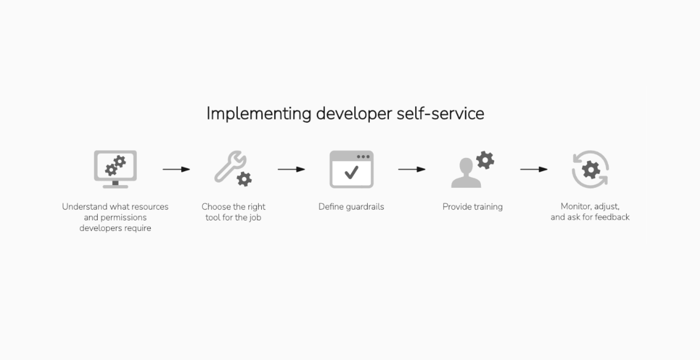
At the core of our platform is the service catalog, which acts like a well-organized library filled with approved blueprints and templates for infrastructure and applications. Around this catalog, we have various user-friendly interfaces like APIs, portals, and GitOps workflows that make it easy for developers to engage with the system. To streamline the process of setting up and configuring resources, we utilize provisioning engines such as Terraform, Pulumi, or Crossplane. To keep everything running smoothly, we also have support systems in place for managing identities, access, monitoring, and billing, ensuring that our platform is secure, easy to observe, and cost-effective for everyone involved.
Component | Description | Role in Platform |
Service Catalogs | A library of pre-approved infrastructure and application blueprints. | Provides developers with consistent, compliant starting points. |
APIs and Portals | Interfaces such as CLIs, dashboards, or GitOps pipelines. | Enable developers to request and manage resources through familiar workflows. |
Provisioning Engines | Tools like Terraform, Pulumi, and Crossplane. | Automate infrastructure provisioning and enforce configuration as code. |
Identity & Access Management (IAM) | Role-based access controls and permissions systems. | Ensure resources are provisioned securely, aligned with organizational policies. |
Monitoring and Billing Systems | Observability, logging, cost tracking, and reporting. | Provide transparency, governance, and accountability across usage. |
When we bring these elements together, we create a platform that strikes a balance between flexibility and control. This setup gives developers the freedom to explore and innovate while ensuring the organization can keep track of everything and manage resources effectively. A thoughtfully crafted architecture brings these components into a unified system, one that grows alongside the business, empowering developers without complicating things unnecessarily.
Tooling Landscape
The self-service infrastructure ecosystem is broad, with tooling options that range from commercial platforms to open-source frameworks. Choosing the right mix depends on organizational scale, existing technology stack, and developer preferences. Generally, you can group these tools into three main categories: internal developer platforms, Kubernetes-based systems, and cloud-native offerings. Each has its own unique strengths, so finding the best fit for your needs is key.
Internal Developer Platforms (IDPs): IDPs, or Internal Developer Platforms, are designed to create a seamless experience for developers when it comes to accessing the essential infrastructure, pipelines, and application services they need. Think of tools like Backstage, which is an open-source solution, and Humanitec, a commercial one. They serve as a friendly entry point to the platform, bringing together service catalogs, templates, and automation workflows into a single, easy-to-navigate interface. This integration not only simplifies the process for developers but also helps streamline their workflow, making their jobs a little less complicated and a lot more efficient.
Kubernetes-Based Self-Service Systems: For organizations using container technology, Kubernetes offers a solid base for self-service capabilities. You can build platforms on Kubernetes by utilizing tools like operators, Helm charts, and projects such as Crossplane, which allow for infrastructure provisioning directly through the Kubernetes API. This way, Kubernetes evolves from just managing containers to becoming a versatile self-service control plane. However, it's important to note that effectively managing this setup does require a good level of expertise.
Cloud-Native Tools: Public cloud providers have made it easier for developers by offering built-in services that allow for self-service without the need to create an entire platform from the ground up. For instance, tools like AWS Service Catalog, Azure DevOps, and Google Cloud Deployment Manager enable developers to quickly and easily set up pre-approved infrastructure and applications as needed. While these services streamline processes and ensure compliance within a single cloud environment, they might restrict flexibility when it comes to hybrid or multi-cloud approaches.
Many organizations take a balanced approach by combining different strategies. Developer experience is enhanced through Integrated Development Platforms (IDPs), while Kubernetes systems bring flexibility and the ability to move across different environments. On top of that, cloud-native tools help teams quickly adapt in cloud-focused settings. The key is to find the right mix that not only makes life easier for developers but also meets the necessary rules and standards set by the enterprise.
Governance and Security
Empowering developers with self-service doesn't mean letting go of control; it’s about finding the right balance. A thoughtfully designed platform provides both freedom and structure, ensuring that the speed of innovation doesn’t compromise important factors like compliance and risk management.
One key aspect of this balance is implementing approval workflows for sensitive resources. While everyday tasks like setting up a development environment can often be automated, higher-risk actions, such as creating production databases or changing network settings, should typically involve human oversight. These approval processes can be fine-tuned to ensure there’s oversight without slowing everything down with cumbersome ticket-based IT systems.
Another crucial component is the concept of Policy-as-Code. This simply means incorporating compliance rules directly into how resources are set up. Organizations can automate the enforcement of these standards, making sure that policies are consistent and scalable. Tools like Open Policy Agent (OPA) or HashiCorp Sentinel enable platform teams to codify rules regarding resource configurations, data residency, and security measures. This not only simplifies compliance but also makes it easier to audit and manage across different environments.
Additionally, adopting least privilege access models is essential. Developers should have the necessary permissions to perform their work, but not more than that. Using role-based access control (RBAC) and detailed IAM policies ensures that users can only access or change resources that relate to their specific roles. When paired with monitoring and logging, this approach helps minimize potential risks if mistakes or misuse occur.
When governance and security are integrated into the self-service experience as supportive guardrails rather than obstructive barriers, developers are free to innovate confidently. This way, organizations can ensure that standards are maintained while still fostering creativity and agility.
Common Pitfalls and How to Avoid Them
Self-service infrastructure has the potential to really enhance our speed and independence, but when things aren’t executed properly, it can fall short of expectations. There are a few common pitfalls that tend to occur quite often.
Over-engineering early: Sometimes, teams aim to create a perfect platform right from the start, but that can backfire. When they skip the step of understanding what developers really need, it often results in a complicated product that nobody wants to use, leading to wasted time and resources. A smarter way to tackle this is to begin with a few key features that can make a real impact. By launching those first, gathering feedback, and then gradually building on that, teams can create something that truly resonates with users.
Ignoring user experience: Even the most technically advanced platform can fall flat if it's not user-friendly. It's important for developers to be able to set up their environments without having to dive deep into the complexities of infrastructure systems. To encourage adoption, we need clear documentation, easy-to-use interfaces, and seamless integration with the workflows developers already use, like command-line tools, GitOps, or web portals.
Weak governance controls: When we allow self-service options without proper guidelines, it can quickly lead to chaos, think of wasted resources, overspending, or even security risks. To avoid these pitfalls, it's essential to establish clear policies from the start. By implementing policy-as-code, ensuring that everyone has only the access they need, and keeping an eye on how resources are being used, we can protect our organization and build trust with leadership. This way, we can enjoy the benefits of self-service without compromising on control or safety.
By keeping platforms simple, user-focused, and governed, organizations can avoid these pitfalls and ensure their self-service initiatives deliver lasting value.
Conclusion
Self-service infrastructure has become essential for how we deliver software today. By moving away from traditional, ticket-based systems to a model where developers have more control, companies can achieve faster delivery times, greater scalability, a better experience for their developers, and improved cost management. It’s important to combine this freedom with strong governance, security, and observability to ensure things are done safely and responsibly.
To succeed in this transition, start with automation as your base. Make security and compliance a part of the process from the get-go, and prioritize usability to encourage everyone to adopt the platform. Begin by addressing a few key use cases that will deliver high value, gather feedback from developers to see the real impact, and then expand from there. This method helps turn what once was a bottleneck in infrastructure into a valuable resource that drives innovation.
If your organization is thinking about making this shift, the message is straightforward: start small, learn quickly, and scale cautiously. Creating a well-thought-out self-service platform is not merely a technical upgrade; it's also a cultural shift that allows engineering teams to work more independently, while ensuring the business can trust that compliance, cost, and security are all in check. Those who adopt this approach will be better equipped to thrive in today’s rapidly evolving digital landscape.
Akava would love to help your organization adapt, evolve and innovate your modernization initiatives. If you’re looking to discuss, strategize or implement any of these processes, reach out to [email protected] and reference this post.

